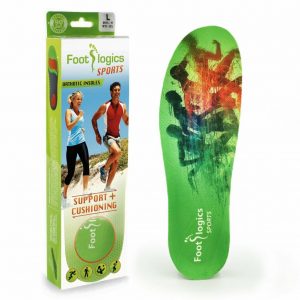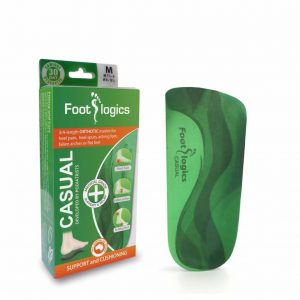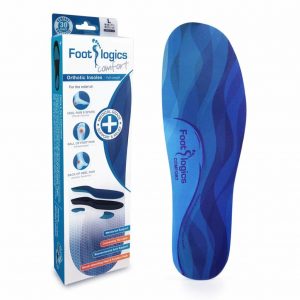Knee Pain

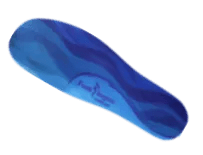
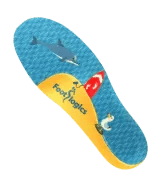
Recommended orthotics for Knee Pain (Patello-Femoral Syndrome)
Knee Pain
If you suffer from knee pain, you’re certainly not alone. This is very common and there are a number of different types. This article focuses on Patello-Femoral Syndrome or Chondromalacia Patellae, which is often referred to as “runner’s knee”.
Knee discomfort is something that can afflict people of all ages and levels of physical activity. It is essential to get an early diagnosis for the knee pain you are experiencing in order to gain a comprehensive comprehension of the structures that are truly contributing to the discomfort you are experiencing in your knee.
What are the symptoms of Patello-Femoral Syndrome?
Characterized by pain between the kneecap (patella) and underlying bone (femur), Patello-Femoral Syndrome, also called Anterior Knee Pain, is the most common form of chronic knee pain. The front of the knee is tender and people who suffer from this condition often experience a grinding or crunching sensation in the joint. Pain is at its worst when you first get up from a chair, climb a set of stairs or begin to move again after a long period of rest. Typical signs of this condition are:
- pain at the front of the knee
- occasional knee buckling
- catching, popping, or grinding sensation
Knee Pain - Causes
Your knee pain can be attributed to a number of factors such as sports injuries or trauma from an accident. But in most cases, general wear and tear is the primary cause of knee pain and is unfortunately part of the degenerative aging process. Over time, the cartilage behind your kneecap softens and wears out, which results in soft tissue tears and breaks. Even if you are still relatively young, years of strenuous activity including running, cycling, soccer, rugby or general labour can affect your knees and accelerate the erosion of knee cartilage.
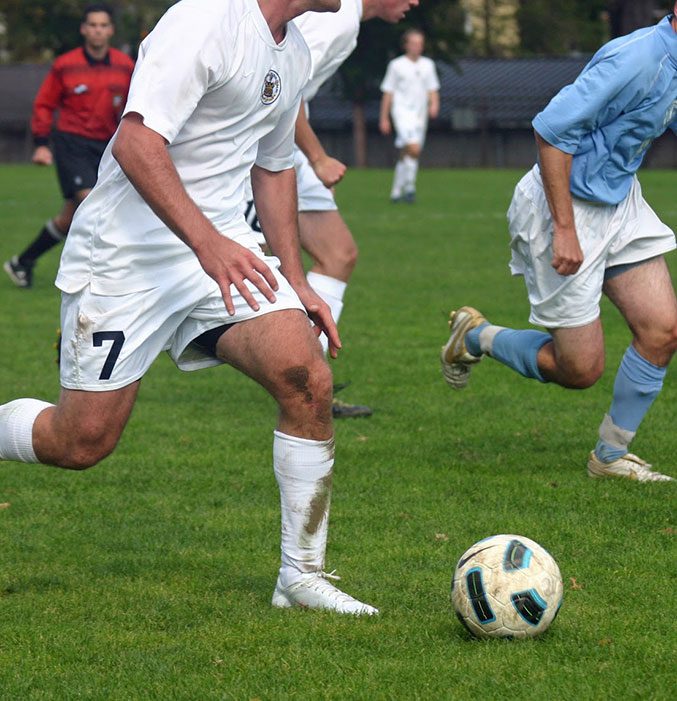
Activities that will make knee pain worse...
- Rugby
- Soccer
- Running
- Cycling
- Strenuous labor (on construction or building sites)
- Sitting in the bent-knee position
- Squatting
- Kneeling for long
Knee Pain and foot biomechanics
In addition to the contributory factors listed above, the biomechanics of your foot also play a significant role in Patello-Femoral pain. The vast majority of health practitioners claim that the positioning of our feet, and therefore, the way we walk, has a profound effect on our lower back, leg, hip and knee function.
Over-Pronation
Did you know that approximately 70% of people suffer from over-pronation? This is a foot condition where a lowering of the arch and an inward rolling of the ankle occurs every time the foot lands. In turn, this also causes the lower leg to rotate inwards.
Over-Pronation and the Knee Joint
Your knee is a hinge joint that links your upper and lower leg. It is designed to flex and straighten your lower leg and unlike the ankle or hip joint, is not made to rotate. However, for someone with over-pronation, as their arch lowers and their ankle rolls inward, the lower leg is also forced to rotate. This puts added stress on the knee joint, causing poor knee function that eventually leads to excess wear and tear. As more time passes, this translates into long-term damage and chronic pain.
Knee Pain Treatment
Given the prevalence of over-pronation, most physiotherapists in Canada assess the feet of patients suffering from knee pain. Depending on the type of knee pain, a number of suitable treatments can be recommended. Sports injuries resulting in knee pain are often treated using the RICE method: Rest, Ice, Compression and Elevation. One of the most common knee injuries in rugby and soccer players is a rupture of the anterior cruciate ligament.
On the other hand, “normal” knee pain, which has developed as a result of strenuous labour or the natural process of aging, calls for a different treatment regimen. Although chronic knee pain is best treated by a licensed physiotherapist, you can do quite a bit yourself. In a worst-case scenario, surgery is the only remaining option to achieve permanent pain relief.
Exercises
It is critical that you strengthen the Vastus Medialis Oblique (VMO) muscles, which are located above and to the inside of your kneecap. Acting as a dynamic stabilizer for your kneecap, VMOs are part of the quadicreps and include the muscles and ligaments in your upper leg in front of your thigh. In a perfectly functioning body, the VMOs easily contract and stay active throughout the entire range of movement. In a body suffering from Patello-Femoral pain, they contract inconsistently and become quickly fatigued. Strong VMOs control the tracking of the patella as the knee is bent and straightened, by making sure the patella stays in the patella groove. For patients suffering from knee pain, strengthening exercises are typically highly recommended by physiotherapists.
Using a knee brace
A knee brace’s primary function is to stabilize the knee joint. The most common is the Patella-Femoral brace, which helps to relieve anterior knee pain through improved patellar tracking. Relatively inexpensive, Patella-Femoral braces can be used in conjunction with other treatments and work to maintain patellar alignment and tracking by resisting patellar lateral displacement.
Foot orthotics for knee pain
Also inexpensive, foot orthotics are highly effective in the treatment of knee pain when coupled with other forms of therapy, especially strengthening exercises. Foot orthotics help re-align the feet and ankles to prevent internal leg rotation (a common cause of patella mal-tracking). Many studies have shown that patella-femoral knee pain is improved with the use of orthotic insoles. In fact, most high-level athletes wear foot orthotics to promote proper leg, foot and knee alignment. Simply by wearing a Footlogics orthotic, proper knee function can be restored through the correction of over-pronation. If your feet roll inwards or your arches tend to fall as you walk, it’s likely that a pair of foot orthotics will offer some degree of knee pain relief.
Insoles for Knee Pain
Knee discomfort is frequently the result of problems that originate in our feet. These difficulties move up the leg and impact the knee, producing regular pain and discomfort as well as the potential for long-term injury. Whether they lack support, overpronate, or are enduring strain in the area of the metatarsals, these problems travel up the leg and affect the knee.
We at Footlogics have a variety of insoles that can help alleviate knee pain by addressing issues with the user’s feet that may be contributing to the discomfort in their knees. In many cases, addressing an individual’s knee pain will only provide short-term or temporary relief from pain and suffering. In order to provide long-term respite and effective treatment, appropriate and focused foot support is required.

